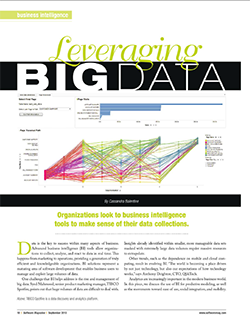The Ledger
Curated content foranalytical business leaders
Tag Archives: Reporting
Leveraging Big Data
 Is big data a challenge for your organization? An article in the September 2013 edition of Software Magazine highlights 3C Software’s Matthew Smith in a discussion about business intelligence tools needed to handle the massive amounts of data that companies collect and analyze.
Is big data a challenge for your organization? An article in the September 2013 edition of Software Magazine highlights 3C Software’s Matthew Smith in a discussion about business intelligence tools needed to handle the massive amounts of data that companies collect and analyze.
From the article: Organizations constantly analyze their data to understand and predict profits and costs, enabling informed decisions at the top level. “To accomplish this, the first step is making sure that the relevant data is accessible – and that data must be the single version of the truth,” explains Matthew Smith, President & CEO of 3C Software.
Check out the article and let us know what you think!
Top Eight Warning Signs You Have a Dysfunctional Costing System – Part 2

The book Designing Strategic Cost Systems: How to Unleash the Power of Cost Information by Lianbel Oliver has a great list of warning signs that may indicate that your company’s costing system is dysfunctional. Make sure you check out Part 1 of this blog where I covered the first four signs. And without further ado, here’s the rest…
#5 – Managers Don’t Understand Product Profitability
Products that are manufactured at high volumes generally have predictable cost results. Why? Because they’re manufactured regularly, operations folks are familiar with the processes and require less ramp-up time to produce the goods. But for some lower volume products, calculating the product cost can become a bit of a mystery. While the labor and materials required is the same for both high and low volume products, a product that is produced infrequently includes a learning curve that can ultimately increase the cost of the product. This additional cost may not be captured, thereby skewing the results and leading business leaders to make incorrect decisions on topics including about product mix, pricing, and customers.
#6 – Accountants Spend Too Much Time on Special Requests for Analysis
If accountants feel like they’re recreating the wheel each time product cost information is requested – Houston, we have a problem! The basic cost information needs of the organization should be readily available through the system allowing cost accountants to focus their efforts on true analysis needed to improve business performance.
#7 – Inconsistencies in Reported Data
Manufacturing companies know all too well that financial accounting and cost accounting are two separate animals with unique purpose. Even with the difference, the core data used for each function should come from the same source. The number of units produced or transactions processed in the costing system should match those in the general ledger. Tight integration of costing, finance and operations systems is required to eliminate problems with inconsistent data.
#8 – Managers Make Suboptimal Decisions
Ever heard the idiom “Robbing Peter to pay Paul”? Many times costing processes are designed to make decisions that are not in the best interest of the organization. One example from the book talks about a manager who inflates standards to meet performance levels without understanding how this decision could adversely impact marketing or pricing. The costing system should help all parts of the business run optimally and help managers make decisions that promote the company’s overall profitability.
We’re hard at work creating cost management content that is interesting to our readers. Subscribe to our RSS feed and you’ll receive instant notifications when we post new articles.
Top Eight Warning Signs You Have a Dysfunctional Costing System – Part 1
Last week I was sitting at my desk trying to think of a blog topic, and the ideas were coming slowly. Since our team has started blogging, my usual well of ideas has dried up because everyone’s saving their best ideas for their own articles. Then out of nowhere, our newest application specialist, Bhavin, decided to pop in to tell me about an interesting book he’d just finished by Lianabel Oliver called Designing Strategic Cost Systems: How to Unleash the Power of Cost Information. After I read the section he shared on dysfunctional cost systems, I knew I had some valuable information that could help manufacturing companies understand the problems inside their costing process.
The book talks about the eight internal warning signs that indicate your costing system is dysfunctional. In part one of this blog, I’ll discuss the first four signs and what companies need to consider when designing their costing processes.
#1 – Financial reports are inaccurate or don’t reflect business operations
Call it a sixth sense, intuition or ESP, but business leaders know how their businesses operate. Plant managers know how swapping raw material inputs or changing to a different production line will impact costs of a product. And when they see reports that don’t line up with those expectations, they tend to distrust the results and ultimately stop relying on the data. To gain acceptance, cost accountants need to take an in-depth look at both their operations and accounting processes to develop a system that is true to their manufacturing process and accounting methodologies.
#2 – Managers are unable to explain financial results
The best way to verify if you know something is to teach it to someone else. Accountants who cannot give a simple explanation to their financial results from a business perspective have no idea what the results mean. It’s easy to hide behind explaining the logic and never tying it back to the actual business. But for managers to clearly relate the results to the business, an alignment between the cost system and the business process it represents is fundamental.
#3 – Managers don’t use financial reports
Oliver discusses four reasons that managers don’t use reports: (1) the reports are too late; (2) the information is stale; (3) the reported costs don’t reflect the true costs of the operation, and (4) they are too difficult to understand. For costing to become an essential component of decision-making for any organization, the costing system must make up-to-date costing information available from a straightforward interface. They need the ability to build reports that capture the information important to the organization in a format that is both digestible and actionable.
#4 – Managers develop their own cost models
If the operations team doesn’t buy in to the costing methodology, they will build their own offline costing models to support their decision-making process. Ultimately, having multiple costing processes existing inside one company can only lead to confusion and negatively affect the company’s profitability. Gaining agreement from the users and customers of cost data within the organization on the costing methodology is a critical step in implementing any costing system.
Fortunately for you (and me!), my next blog is already underway. Stay tuned for part two where I’ll cover the second four signs that could mean your cost system is dysfunctional.
Update: Read Part 2 of this blog series to read about the final four warning signs.
Want to make sure you don’t miss part two? Subscribe to our RSS feed and you’ll receive instant notifications when we post new articles to our blog.
How important is forecasting to the cost accounting function at your company?
Most people associate cost accounting with analyzing past events – calculating actual costs, analyzing yields and variances, and creating reports. More and more, companies are looking for ways to grow their cost accounting function to include predictive analysis to help with decision-making throughout the organization.
How has the cost accounting function changed in your company? Is there a bigger emphasis on forecasting future performance? And, what tools are you using to implement this new approach?

